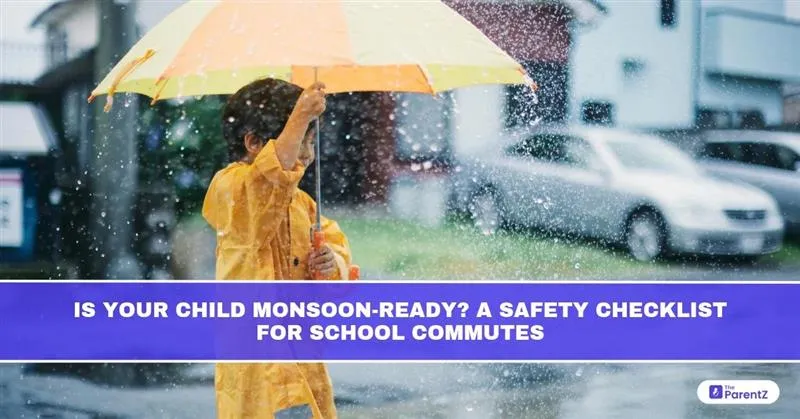Monsoon mornings often mean muddy roads, waterlogged lanes, splashing vehicles, and slippery pavements. For school-going children, especially those who walk or use public transport, the risk of accidents, infections, and electrocution increases significantly during this season.
According to the Indian Road Safety Campaign (IRSC), more than 30% of school-going children in urban India commute independently during monsoon months, often without full protective gear or hazard awareness.
Here is a child-focused monsoon safety checklist for parents to ensure your child is well-prepared—head to toe—for a safe, dry, and hygienic journey to school and back.
1. Rain Gear That Works (Not Just Looks)
- Choose a full-length raincoat with a hood that fits snugly—preferably one with reflective stripes.
- Avoid oversized raincoats that drag and increase fall risk.
- Pack an extra plastic bag in the school bag for wet clothes or shoes if they get soaked.
- Umbrellas are not ideal for younger children—they often block vision and get blown away.
Pro Tip: Get brightly colored rain gear so your child is more visible to drivers in low-light, rainy conditions.
2. Monsoon-Ready Footwear
- Invest in non-slip, closed waterproof shoes with good grip. Avoid open sandals, Crocs, or slippers.
- Keep an extra pair of socks in the school bag.
- Ensure shoes are properly dried overnight to prevent fungal infections.
Tip from pediatricians: Persistent damp shoes and socks can lead to athlete’s foot or skin infections, especially in school-going kids who sit for long hours.
3. Safe School Route Review
- Walk the school route with your child and identify high-risk zones: open drains, slippery steps, waterlogged alleys, or exposed electric poles.
- Teach them to never walk through unknown puddles, which may hide open manholes or sharp objects.
- If your child uses a school bus, ensure pickup/drop-off points are not in flooded or low-visibility areas.
Parent tip: During heavy rains, schools may change gates or bus stops—stay updated and review any new route changes with your child.
4. Essentials to Keep in the Bag
- Tissue pack or face towel
- Mini hand sanitizer or soap paper
- Spare mask (if needed, especially with colds/coughs circulating)
- Plastic pouch for keeping notebooks dry
- Small waterproof pouch for ID, bus pass, and keys
5. Teach Them About Electrical Hazards
- Never touch electric poles, wires, or switch boxes even if nothing seems wrong.
- Stay away from transformers or any device emitting sparks.
- If you see an exposed wire or flooded electric pole near your child’s school, report it to the school authorities immediately.
6. School Bag Waterproofing
- Use a waterproof school bag cover or a bag with built-in rain protection.
- Avoid canvas or cloth bags, they soak easily.
- Keep books in plastic folders inside the bag to protect against leaks.
7. Clothing Do’s and Don’ts
- Full-length light cotton clothes dry faster than denim or polyester and prevent fungal rashes.
- Avoid layering too much—it retains moisture and increases discomfort.
- If the child’s uniform gets wet during the commute, ask the school if they can change into a spare or keep one at school.
8. Post-School Routine
- Always change out of damp clothes and wash feet and hands after coming home.
- Check for signs of rashes, itching, or swelling, especially between toes.
- Dry shoes and raincoats properly near ventilation not inside closed cupboards.
9. Keep Your Child Informed, Not Afraid
Teach your child to:
- Stay calm if stranded due to weather
- Call parents or alert the school if unable to travel
- Never accept rides from strangers during heavy rains
- Wait under covered areas not under trees or poles
Use age-appropriate language and stories to teach these habits without inducing fear.
10. Keep Emergency Contacts Handy
- Laminate a card with your phone number, school number, emergency contact, blood group, and address.
- Place this in a zip-lock pouch inside your child’s school bag.
Conclusion
Rainy days don’t have to mean risky school runs. With the right gear, a little preparation, and some early training, your child can navigate their school commute safely even in a downpour. Equip them, teach them, and watch them shine even on cloudy days.








Be the first one to comment on this story.